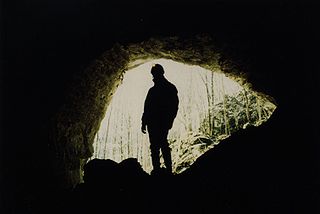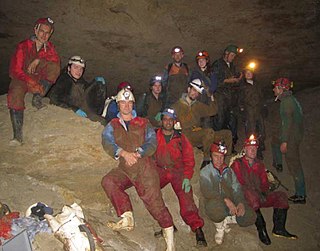Related Research Articles

Caving – also known as spelunking in the United States and Canada and potholing in the United Kingdom and Ireland – is the recreational pastime of exploring wild cave systems. In contrast, speleology is the scientific study of caves and the cave environment.

Speleology is the scientific study of caves and other karst features, as well as their make-up, structure, physical properties, history, life forms, and the processes by which they form (speleogenesis) and change over time (speleomorphology). The term speleology is also sometimes applied to the recreational activity of exploring caves, but this is more properly known as caving, potholing, or spelunking. Speleology and caving are often connected, as the physical skills required for in situ study are the same.

The National Speleological Society (NSS) is an organization formed in 1941 to advance the exploration, conservation, study, and understanding of caves in the United States. Originally headquartered in Washington D.C., its current offices are in Huntsville, Alabama. The organization engages in the research and scientific study, restoration, exploration, and protection of caves. It has more than 10,000 members in more than 250 grottos.

New Zealand Speleological Society is a national organisation for recreational cavers in New Zealand.
Abrakurrie Cave is a wild cave on the Nullarbor Plain in Western Australia. It is located about 48 kilometres (30 mi) north west of Eucla and is reported to have the largest single cave chamber in the southern hemisphere, and that stencils in the cave are the deepest penetration of Aboriginal art of any cave system in Australia.

The Wellington Caves are a group of limestone caves located 8 kilometres (5.0 mi) south of Wellington, New South Wales, Australia.
GSG may refer to:

EGMA Sinkhole, a.k.a. Peynirlikönü Sinkhole, is a sinkhole and the deepest cave in Turkey. It is located at Sugözü village of Anamur, Mersin. The sinkhole is 1,429 m (4,688 ft) deep and 3,118 m (10,230 ft) long. EGMA is an acronym that stands for Evren Günay - Mehmet Ali Özel.

The British Cave Research Association (BCRA) is a speleological organisation in the United Kingdom. Its object is to promote the study of caves and associated phenomena, and it attains this by supporting cave and karst research, encouraging original exploration, collecting and publishing speleological information, maintaining a library and organising educational and scientific conferences and meetings.
Uamh an Claonaite is the longest cave in Scotland. It consists of a series of dry passages and a series of at least six sumps which have been dived over the years.
There are a number of caving organizations throughout the world.

Recreational caving in the United Kingdom dates back to the mid nineteenth century. The four major caving areas of the United Kingdom are North Yorkshire, South Wales, Derbyshire, and the Mendips. Minor areas include Devon, North Wales, and Grampian.
British Speleological Association (BSA) was founded by Eli Simpson and others in 1935. It was instrumental in the discovery of Lancaster Hole and other caves. In 1973, it merged with the Cave Research Group of Great Britain to form the British Cave Research Association (BCRA).
Sydney University Speleological Society (SUSS) is a caving group based in Sydney, Australia, which aims to unite University of Sydney graduates, undergraduates, staff and all other people who are interested in the exploration and mapping of cave systems. The society fosters speleology as a science and sport and co-operates with other bodies in the furtherance of these aims. SUSS was founded in 1948 and is the oldest caving group on mainland Australia. It has been heavily involved in the exploration and mapping of various Australian cave systems since its formation. The society pioneered the sport of cave diving in Australia and was a founding member of the Australian Speleological Federation.

The Speleological Union of Ireland (SUI) is the official representative body of cavers in Ireland, both in the Republic of Ireland and in Northern Ireland. It is affiliated with the Irish Cave Rescue Organisation.

Agnes Milowka was an Australian technical diver, underwater photographer, author, maritime archaeologist and cave explorer. She gained international recognition for penetrating deeper than previous explorers into cave systems across Australia and Florida, and as a public speaker and author on the subjects of diving and maritime archaeology. She died aged 29 while diving in a confined space.
Artur (Conrad) Kozłowski was a Polish cave diver who spent his last years in Ireland. Amongst other achievements in cave exploration, he set the record for the deepest cave dive in Great Britain and Ireland at a depth of 103 m (338 ft).
International Union of Speleology is a non-profit, non-governmental organization to promote interaction between academic and technical speleologists from a wide range of nationalities for the purpose of developing and coordinating international speleology in all of its scientific, technical, cultural and economic aspects.
Pollatoomary is the deepest explored underwater cave in Ireland. It has been explored to an underwater depth of 113 metres (371 ft). The explored limit of Pollatoomary is also 23 metres (75 ft) deeper underwater than that of the terminal sump in Wookey Hole Caves in Somerset, England, which previously held the record for the deepest underwater cave in Britain and Ireland.

Jingling Pot is a limestone cave in West Kingsdale, North Yorkshire, England. Located adjacent to Jingling Beck, it is a lenticular-shaped 45-metre (148 ft) deep shaft that descends straight from the surface. At the bottom the rift extends to the north and descends steeply into a further chamber, at the end of which the initials of the original explorers may be seen scratched into the rock. A narrow shaft in this second chamber drops into a complex of small crawls and rifts, which approach close to a passage in the One-armed Bandit Series of Aquamole Pot. A second set of shafts descend parallel to the surface shaft. These can be entered through a rock window a little way below the entrance.
References
- ↑ "Grampian Speleological Group information" . Retrieved 2010-04-16.CS1 maint: discouraged parameter (link)